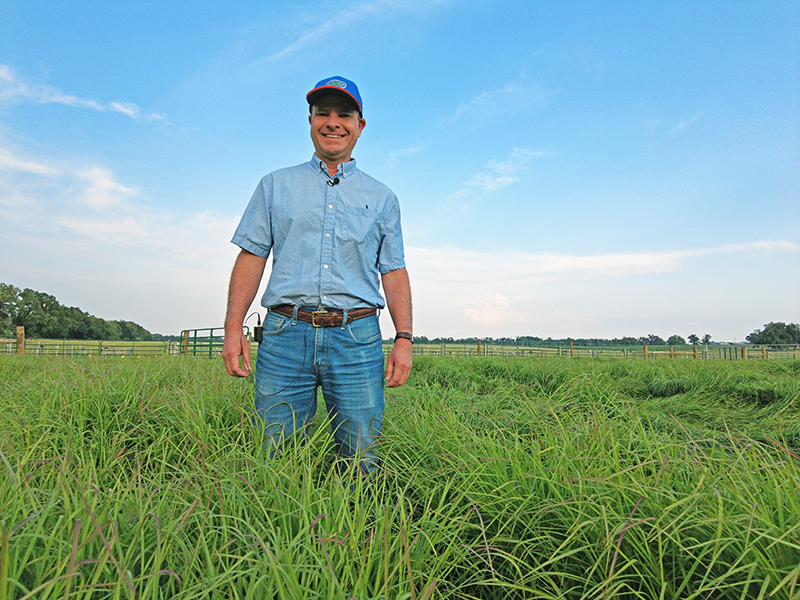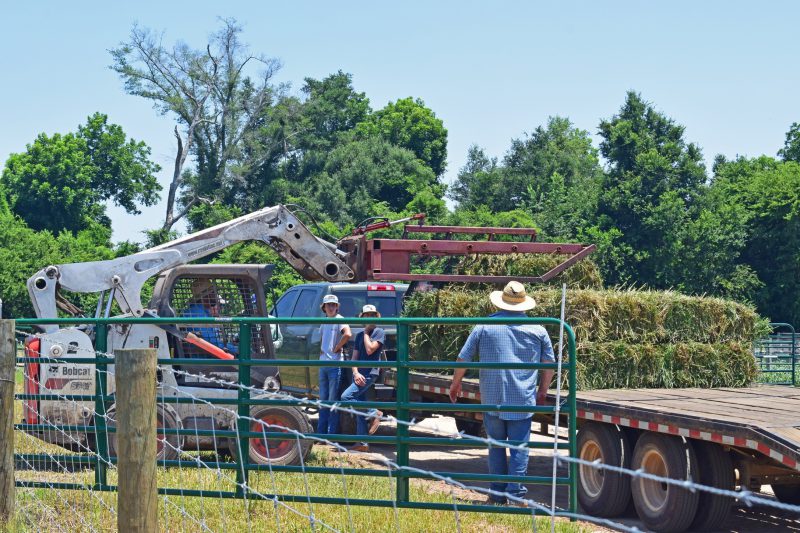
Dr. Jose Dubuex and the NFREC Beef Unit Crew will be harvesting Gibtuck Limpograss for distribution to farms to establish a 1-acre nursery on July 9, 2024. . This photo was taken on May 18, 2022, so you can see how much earlier in the spring this grass grows than bahiagrass. Credit: Doug Mayo, UF/IFAS
Limpograss, Hermathria altissima, is a warm-season perennial grass that has been used for cattle production in Central and South Florida by beef cattle producers for a number of years. With the development of a new cultivar called ‘GibTuck,’ researchers have spent several years evaluating the adaptation of this grass for the Panhandle. Limpograss has become very popular in Peninsular Florida because of its high digestibility, cool-season growth, and tolerance of poorly drained soils. There is a great opportunity to add this new forage grass to diversify your operation in the Panhandle.
Limpograss has a longer season of growth than Bahiagrass or Bermudagrass, so it can help bridge the gap between summer perennial grasses both before and after winter annual forages. Limpograss can also be stockpiled and strip grazed to reduce the need for hay feeding from October through mid-January. Protein supplementation is required, however, for grazed animals on stockpiled and mature limpograss. Limpograss is also more tolerant of poorly drained soils than either of our traditional summer perennial grasses. Contact your local county extension agent for more details on uses and management of limpograss for forage production.
One of the key challenges with Limpograss, however, is that it must be planted from fertilized, mature, vegetative material and not from seed. Limpograss is also injured by 2,4-D herbicides during the warm season, so be careful with herbicide selection. This is not the case with dicamba or metsulfuron products, so there are some good weed control options available for broadleaf weed issues.
The staff at the North Florida Research and Education Center’s Beef Unit have organized a distribution day to share Gibtuck Limpograss planting material with local forage producers on July 9, 2024. The event will be held at the Beef Research Unit located at 4925 Highway 162, Greenwood Florida. With $50 advanced registration (plus $5.20 handling fee), 30 farms will be provided approximately 1,500 pounds of freshly baled cuttings or tops for planting a one-acre nursery their farms. Producers can choose either 24 square bales or 4 small round bales for distribution at their farm. (If you have not planted limpograss before, please watch the video and read through the recommended steps for establishment below the registration link.)
Producers will be scheduled with appointments every 30 minutes between 9:00 and 12:00 Central Time to prevent long waits for materials at the Beef Unit. Please bring a flatbed or open utility trailer for loading (not a closed livestock trailer) that can safely haul 1,500 pounds. These bales will contain live plant material that should be planted as soon as possible after pickup, so make sure plots are well prepared and adequate labor is available for even distribution and planting the same day. For questions related to planting material pick up on the distribution day contact Jose Dubeux or Tina Gwinn at 850-526-1611.
2024 Registration link: https://UF-IFASLimpograssPlantMaterial2024
–
–
Recommended steps to successfully establish a 1-acre limpograss nursery.
- Select your nursery area that can be easily accessed but protected from grazing.
– - Soil test to determine if the pH is 5.5, and apply lime, if needed, before discing.
– - Spray 2-3 quarts/acre glyphosate to kill existing grass and annual weeds. Leave undisturbed for 14-21 days before discing to prepare for planting.
– - Disc two to three times to prepare a good seed bed. Utilize a drag behind the disc or soon after discing to level the area prior to planting date. You want your nursery nice and smooth for future harvests.
– - Pick up planting material on July 9th based on you assigned appointment time. Farms will be staggered every 30 minutes from 9:00 AM to 12:00 PM.
– - Plant as soon as possible after picking up material not to exceed 6 hours. Fresh wet materials will go through a heat and rapidly degrade in a matter of hours. Don’t leave planting material sitting in the sun prior to planting.
– - Evenly spread planting material by hand or with a sprig-spreader over the entire acre. Break square bales into pads and use a tedder to evenly distribute. Use a bale buster, sprig-spreader, or hay unroller to evenly distribute material from round bales. A tedder can also be used, if necessary.
– - Disc planting materials into the top 2-3 inches of soil. Adjust the front disc gang angle to reduce aggressive digging and deep coverage.
– - Use a roller or cultipacker to firm up seed bed after discing materials into the soil.
– - Fertilize with 30 lbs. N/acre and P & K based on soil test recommendations after emergence, and another 50 lbs. N one month later.
– - Allow Limpograss 2-3 months of growth before mowing, grazing, or harvesting for hay or baleage.
= - Do not use pasture herbicides containing 2,4-D to control weeds during the warm season as it will injure Limpograss. Contact your county agent for recommended herbicide options based on the weed issues in your nursery.
– - Your nursey should be well established the following spring. One acre should provide adequate materials for 10 acres of planting the following year.
– - Burn off frosted grass in early February and fertilize in late March/early April and allow 8-10 weeks of growth to maturity before harvesting planting material. Fertilize after harvest for additional planting material. Limpograss can be planted from April through August when the grass is mature and there is adequate moisture for planting.
—

Limpograss planting material being loaded on a flatbed trailer for planting a 1-acre nursery. Credit: Doug Mayo, UF/IFAS
- 2024 Average Farmland Rental Rates and Worker Wages Summary - December 20, 2024
- 40th Annual Beef Cattle Conference & Trade Show – February 12 - December 20, 2024
- Friday Feature:Carol of the Carillon Bells at UF - December 20, 2024
